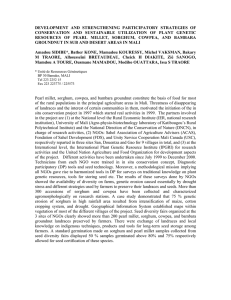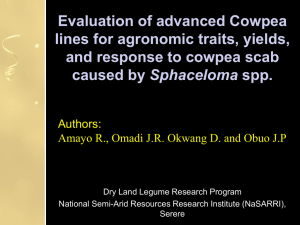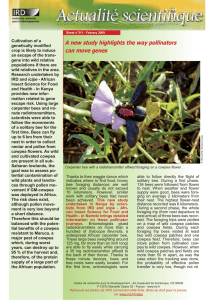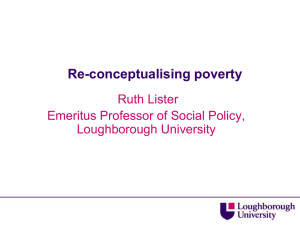Coulibaly/IITA
advertisement
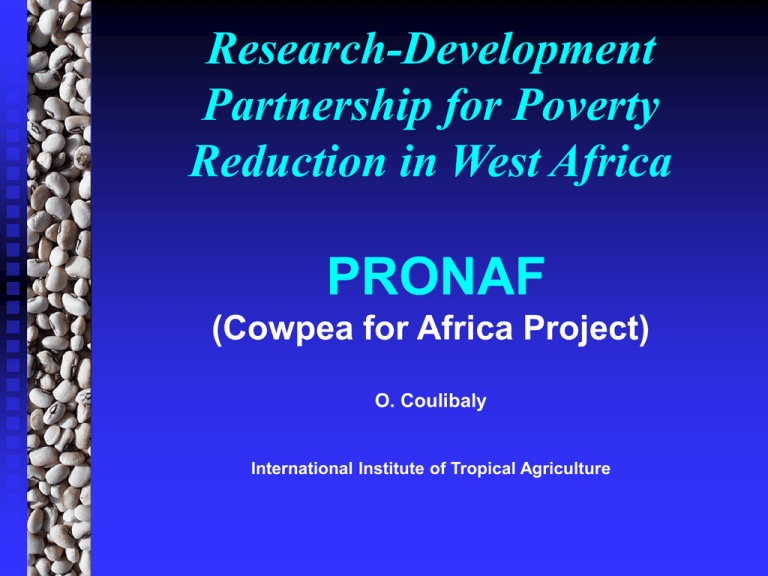
Research-Development Partnership for Poverty Reduction in West Africa PRONAF (Cowpea for Africa Project) O. Coulibaly International Institute of Tropical Agriculture Objectives and Strategies for a Research and Development Partnership High Productivity Reduction of losses Reinforcement Capacity/decision Access to markets (Input/Products) Access to Capital Access to Social Services Food Security (Quant, qual) * REVENUES (Ag-Nag) Environmental Protection POVERTY REDUCTION Productivity and Quality of Products Development and marketing of des Varieties, (Output, diseases, insects, drought, quality). Post harvesting Technologies Seeding multiplication Field of a new variety of Cowpea in Nigeria Synthesis of activities carried out: test results from FODESA villages fig 9 : Performance moyenne des variétés de niébé de cycle précoce résistantes à la sécheresse et au Striga/paysan à ségou en 2003 IT95K-1072-57 IT98K-818-35 IT96D-610 Locale 1760 1800 1600 1400 1320 1200 rendement (kg/ha) 1200 1120 1080 1000 1080 880 800 680 600 600 600 520 600 360 400 400 360 320 400 240 160 120 200 0 Boubou Traore Bade Diao Adama Keita variétés Mai Traore Lassine Keita Long term technical solutions Develop an alternative to chemical pesticides / Environmental health and protection (Semi-mechanised, women’s work Extracts of Neem and Papaya Working mechanisms SNRA Benin, Burkina Faso, Mali, Niger, Nigeria (Regional Steering Committee) Pays National committee include IFAD development projects Collaboration with NGOs, Organisations, Farmers, Transformers, Suppliers, etc. Research Collaboration - Development of networks with Universities Constraints: Delays in release of funds Reinforcement of Optimal decisional capacities Farmers observing and analysing the agro-ecosystems of the Cowpea A woman farmer presenting results after a group analysis. Session of the reinforcement of Impact Analysis Capacities (Food Security, Environment, Poverty Reduction) IFAD Projects, SNRVA,Public-private, NGO. (Mali, 2002) Mali (2), Benin (3), Guinea, Togo, Ghana, Kenya, Nigeria, Cameroon FIDA… USAID, DANIDA.. AfDB Contribution of the NIEBE Filière to Food security, Environmental protection and poverty reduction . Empower Partners Develop and broadcast Technologies • • • • Germoplasm Post harvest fields Durable systems Information on Business Markets • Analyse/Decide Agricultural policies • Producers • Suppliers (Private) • Seed producers • Development agents • Researchers • Public figures holding policy making power Facilitate Collaboration/Partnership with ONGs, Private and Public sectors, Networks, Universities, AATF Partenariat RechercheDeveloppement (Grant-Investissement) FIDA PRONAF (IITA-SNRA) IFAD Grant Projects Investments IFAD (others) Actors/Parteners Productors (Women) Organisations Transformers Vendors Consumers Politicians Burkina Faso Bénin Mali CES-AGF, PDRSO PAMER, PDRSO,CESAGF Typology, FFF, Capacity (Training Impact) 2002 PDRT Training Impact Evaluation-Filière studies Impact assessment on technologies 2004 Training Impact IPM, Var., Evaluation de Impact-Evaluation 2002 2004 2004 2005 PROMIC, PAGER FODESA, PDR-MS, PDZL PDR-MS PDZL 2003 2005 2005 Scientific collaboration with the Bean/Cowpea Collaborative Research Support Programme (B/C CRSP), the African Agricultural Technology Foundation (AATF), NGIGA, universities (in Africa, Australia, Europe, the United States). studies on the perception and acceptance of genetically modified cowpea varieties in West Africa analysis of the production and distribution pipeline for cowpea varieties (both genetically modified and nongenetically modified) evaluation of the potential regional impact of genetically modified cowpea in West Africa, and strategic recommendations undertaking of a policy dialogue to support new institutional arrangements for sustaining technological changes Commercial losses due to aflatoxins US$670 million (9 African Countries) Peanut Milk Corn Rural Economics Training Modules 1. Analysis of the (technical-institutional) impact on poverty 2. Economics of the quality and hygiene of agricultural products (standards) 3. Competitiveness of agriculture (international trade) 4. Economics of agricultural pipelines 5. Economics of biotechnology 6. Gender, equity and poverty 7. Participatory methods – partners 8. Public-private-NGO partnership 9. Economics of health – AIDS/malaria – agriculture LABORATORY FOR CAPACITY BUILDING IN SOCIAL SCIENCES INTERNATIONAL INSTITUTE OF TROPICAL AGRICULTURE THANK YOU u.coulibaly@cgiar.org

